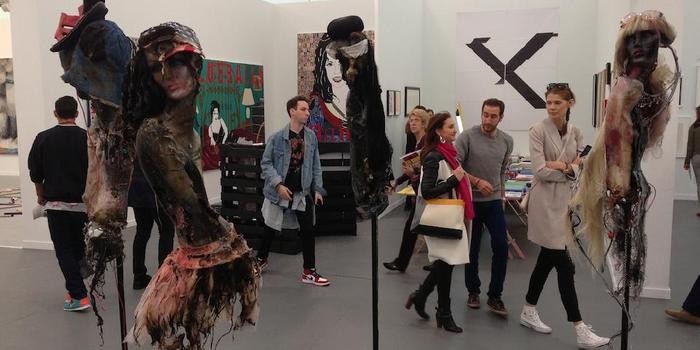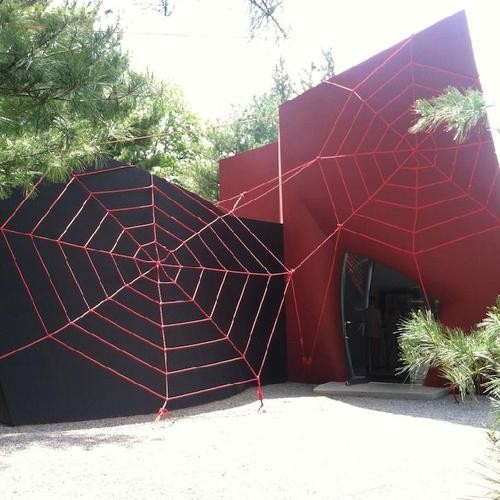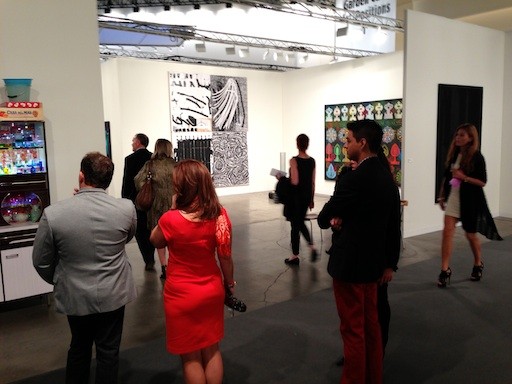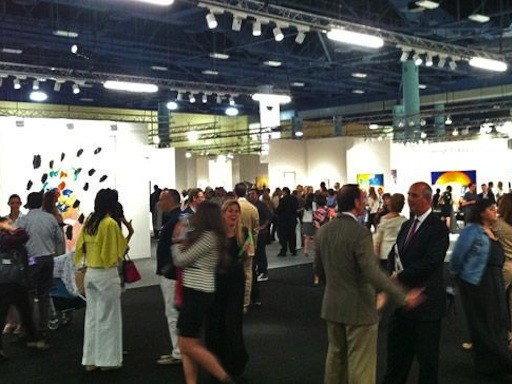The last day of Frieze New York was a grueling one.
“I can’t drink anymore champagne,” a man, clad entirely in black, said on the ferry to Randall’s Island as one of the last stragglers to the fair. “Then again, ask me in an hour.” The noon Water Taxi had filled up with the last dead-enders of Frieze week, latecoming out-of-towners, plus a few people who simply had Monday off and hoped to catch the fair, which ended yesterday at 6 p.m.
“These are good problems to have,” the man concluded as he stepped off the ferry. It was a popular sentiment after the week’s explosion of fairs, parties, and openings: more than one weary and well-dressed person strolling through the tent could be overheard complaining (or boasting), “I’m exhausted.” And no wonder: many of them had seen the fair week through from Wednesday night's “Orange Friezes” at the MoMA PS1 kick-off party to Sunday day-drinking on the Roberta’s patio at Frieze. A Barbara Kruger ironically greeted those walking in the North entrance, jeering in giant white block letters “YOU LOOK GOOD.” Suddenly those punchy, text-based works seemed more urgent—and sobering.
A Gardar Eide Einarsson at Maureen Paley read in similar block text “ARCHITECTURE OF TOMORROW” under a loudly rippling tent (whose Twitter handle "@FriezeTent" saw a revival over the weekend from last year). Those manning the booths, who had been frantically running around on Thursday with iPhones and iPads ablaze, mostly sat back and watched the lower traffic stroll by. Some works could be better enjoyed without the buzz. The girl delivering the monologue of Tino Sehgal’s Ann Lee at Marian Goodman had been hard to hear over the din of Thursday’s crowds, but Monday’s calm allowed for easier viewing. Doug Aitken’s ART (white) at 303 Gallery spelled out the word in shattered glass—a good reflection of how many fairgoers felt.
In the early afternoon, New Museum curator Jenny Moore and Dominic Molon, chief curator at the Contemporary Art Museum St. Louis, spoke at “When the Past Isn’t Past,” a Frieze Talk addressing the way recent exhibitions have been “packaging” the not-so-distant past. “You’ll have to bear with me with my somewhat muddled voice and brain,” Molon began. “Too much cheap beer and cheaper conversation.” He addressed his museum’s upcoming exhibition “Space Is the Place,” calling it a conscious effort not to be hemmed in by the fashionable “decade-ism” described by moderator Dan Fox of Frieze magazine.
But it was the New Museum’s “1993: Experimental Jet Set, Trash and No Star” exhibition, showing until May 26, that defined the conversation—pinpointing historical year just before the craving for authenticity became stylized, according to Moore, and the underground went mainstream. Both Moore and Molon questioned whether the glut of the market and the hunger for new art to sell has caused a closer re-reading of the old and overlooked. “There are so many more exhibitions now,” Moore said. “For every decade show there are 15 different other exhibitions about some other aspect of contemporary art.”
On the opposite side of the fair, FOOD was serving a one-day-only tribute Gordon Matta-Clark’s original “Bone Menu” of oxtail soup, salad, and carrot juice. Meanwhile at Mission Chinese, grungy green-haired cashiers handed out the last few Kung Pao pastramis to a soundtrack blaring the likes of Oasis’s “Wonderwall.” In fact, after the weekend’s confusion and sleeplessness, I forgot my wallet at a table there at about 5 p.m.– just in time to realize once off the bus and back in Manhattan that I’d probably lost it to that giant white tent for good.
At the right, find an excerpt from our Frieze New York collection, or click here to see the entire collection.























